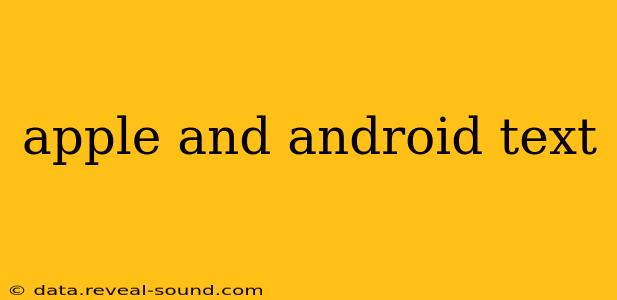Choosing between Apple's iMessage and Android's messaging apps can feel like choosing sides in a tech war. Both offer text messaging, but the experience, features, and compatibility differ significantly. This comprehensive guide dives deep into the nuances of Apple and Android text messaging, helping you understand which platform best suits your needs.
What's the Difference Between iMessage and Android Messages?
The primary difference lies in the underlying technology and ecosystem. iMessage is Apple's proprietary messaging service, integrated seamlessly into the iMessage app on iPhones, iPads, and Macs. It uses Apple's servers to send messages, offering features like read receipts, typing indicators, and high-quality image and video sharing. Android Messages, on the other hand, is Google's default messaging app, primarily using standard SMS/MMS protocols. While many Android phones now incorporate RCS (Rich Communication Services), a more advanced standard aiming to bridge the gap with iMessage, full interoperability isn't universally achieved.
How Does iMessage Work?
iMessage leverages Apple's infrastructure for end-to-end encrypted communication between Apple devices. This means only the sender and recipient can read the messages. The use of Apple's servers allows for rich features, including:
- Read Receipts: Confirm when a message has been read.
- Typing Indicators: Show when someone is composing a message.
- High-Quality Media Sharing: Send images and videos in their original quality without compression.
- Group Messaging: Create and manage group chats with multiple participants.
- Reactions: Quickly respond to messages with emojis.
How Does Android Messaging Work?
Android messaging traditionally relies on SMS (Short Message Service) and MMS (Multimedia Messaging Service) protocols, which are older standards supported by almost all mobile phones. While functional, these protocols have limitations:
- Lower Quality Media: Images and videos can be compressed, reducing quality.
- Limited Features: Lacks the rich features of iMessage, such as read receipts and typing indicators.
- Compatibility Challenges: Sending messages to iPhones often results in SMS/MMS messages, losing the enhanced features.
However, RCS (Rich Communication Services) is changing this. RCS aims to bring many iMessage features to Android, offering improved quality, typing indicators, and read receipts. However, adoption isn't universal, and messages sent to non-RCS users will still revert to SMS/MMS.
Can iMessage and Android Messages Communicate?
This is a frequent point of contention. When an iMessage user sends a message to an Android user, the message typically defaults to SMS/MMS if RCS isn't enabled on both devices. This means the rich features of iMessage are lost. The Android user will see a standard text message, lacking the visual enhancements and features. The situation is improving with wider RCS adoption, but it's still not a completely seamless experience.
What Are the Pros and Cons of Each?
iMessage (Apple):
Pros:
- Seamless integration within the Apple ecosystem.
- Rich features like read receipts, typing indicators, and high-quality media sharing.
- End-to-end encryption for enhanced security.
Cons:
- Limited compatibility with Android devices.
- Relies on Apple's servers, creating dependence on Apple's infrastructure.
Android Messages:
Pros:
- Wider compatibility with all mobile phone types.
- Gradually improving with RCS adoption, bringing features closer to iMessage.
- More platform-agnostic and less tied to a specific ecosystem.
Cons:
- Traditional SMS/MMS has limitations in features and media quality.
- RCS adoption isn't yet universal, leading to inconsistencies in messaging experience.
Which Messaging Platform Is Better?
The "better" platform depends entirely on your priorities and the devices used by your contacts. If most of your contacts use iPhones, iMessage offers a superior experience. However, if you need broader compatibility with Android users, Android Messages (especially with RCS enabled) is a more practical choice. Ultimately, the best approach may involve understanding the limitations of each platform and adjusting your communication accordingly.
